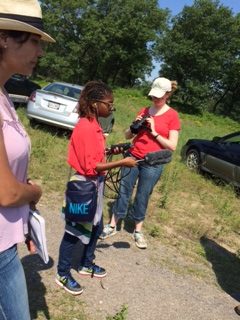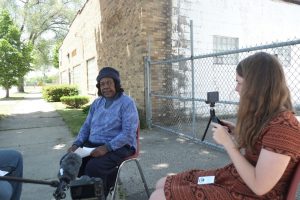Research Area: Urban Environmental Equity
Urban Environmental Equity
How do projects that aim to improve environmental quality affect social equity?
Do differences in stakeholder perceptions of human-nature relationships create barriers or opportunities for action toward local visions for a sustainable future?
How (if at all) do interactive public research products (e.g. participatory research, virtual focus groups, and citizen science initiatives) change the relationship between researchers and communities. To what extent does this serve sustainability as an area of research and as a societal goal?

Social equity as a component of sustainability often gets left aside in favor of environmental quality and economic prosperity. Yet, struggles for social equity are important to bringing about change that supports the basic principles of democracy and important tenet of the ethical stance that access to safe and healthy places to live, work, and play are a basic human right and not a luxury good only available to those born into privilege. However, we do not live in a blank slate world. Historical legacies of pollution have co-located undesirable land uses with marginalized people. Research has demonstrated that in many cases, efforts to create environmental benefits and reduce environmental burdens have been completed without consideration for their social impacts. This has allowed for environmental and economic gains while displacing marginalized people. The interventions have not served sustainability because they do not make an effort to dismantle the structures (for example, racism) that allowed for this uneven development in the first place.
Our research draws from both qualitative and quantitative social science traditions to understand how environmental clean-up and urban planning efforts might better use their limited resources to create additional movement toward sustainability. We also reflect on the roles researchers and their research products play in this process.
The envisioned outcomes
- Inclusive planning efforts and informed decision-making.
- Enhanced collaboration between social service and water resource professionals.
- Integration of environmental equity concerns into future initiatives to plan for water sustainability.
Faculty
Bethany Cutts
Andrew Greenlee (University of Illinois, Department of Urban and Regional Planning)
Current graduate students
El Lower (University of Illinois, Department of Natural Resources and Environmental Sciences)
Kaitlyn Hornik (University of Illinois, Department of Natural Resources and Environmental Sciences)
Betsy Breyer (University of Illinois, Department of Geography and Geospatial Sciences)
Featured Project: Mapping vulnerabilities in Milwaukee Wisconsin’s EPA-designated Areas of Concern
Their Mission?

Dr. Bethany Cutts, in collaboration with faculty, graduate students and undergraduate research assistants from the University of Illinois, is working to build concern for environmental justice into efforts to build a sustainable water city in Milwaukee, WI.
Using video-based interviews with over 35 stakeholders, the team examines how people interpret vulnerability to water pollution, the impacts of efforts to clean up local waterways, and visions for how to best improve equity in Milwaukee. Eight graduate students and 1 high school student completed interviews, which were transformed into three short documentary segments by Kaitlyn Hornik as part of her MS thesis (University of Illinois, 2016).
Why does this matter?

With the goal of creating more just and sustainable cities, it is necessary to enact multilevel and dynamic interventions that recognize a constant moving baseline. Our work shows that interventions across scales and stakeholders exist but may be working in parallel rather than in tandem. Bringing cohesion and mutual understanding between stakeholder priorities and acknowledging the potential for complex interactions across scales for governance can help to mitigate the potential for development conflicts that pit social equity against environmental and economic benefits.
The practices and processes involved in video-based interviews contribute suggest new opportunities for scholars to connect their scholarship to efforts by residents and decision-makers to incorporate equity into their visions for sustainability. Creating videos and showing them to focus groups provided two opportunities to gain insight into stakeholder understandings of local sustainability challenges.
Unearthing the differences and similarities and putting them in dialogue through video allows us to begin to understand what causes the mismatch between environmental justice and sustainability priorities.
Findings generated by the research outcomes and the research process has led to valuable insights and conclusions that could not have been drawn through top-down, expert driven research. While turning the research process upside down and learning from the community itself may create more challenges – and perhaps questions that no one can answer yet – these are exactly the issues that must be brought to the fore to be discussed and handled in a way that uplifts and disrupts patterns of environmental, social, and economic disparity.

This research was completed with funding from Illinois-Indiana Sea Grant, grant no. NA14OAR4170095 “Mapping Social Vulnerability in EPA-designated Areas of Concern” and the University of Illinois Urbana-Champaign Graduate College Focal Point Initiative “Urban Environmental Equity” For more information, please visit the project website: https://publish.illinois.edu/urbanequity/
Examples of Recent Publications from PRTM Faculty in the area of Urban Environmental Equity
Hornik, K., B. B. Cutts, A. J. Greenlee. (2016) Community Theories of Change: Linking Environmental Justice to Sustainability through Stakeholder Perceptions in Milwaukee, WI. International Journal of Environmental Research and Public Health. 13(10), 979; doi:10.3390/ijerph13100979
Cutts, B.B., A. Greenlee, N. Prochaska. C. Chantrill, J. Wilhoit, A. Contractor, N. Smebak,. Social Change in a Watershed Planning – A River Runs Through It. Landscape and Urban Planning (Submitted February 28, 2015 to Accepted pending revisions, revision submitted November 10, 2015)
Wilson, A.; B. Cutts, A. Greenlee. 2014. Community Perceptions of the Environmental Remediation Effort in the Milwaukee River Estuary. I-ACES the undergraduate research journal 1(1):11-20 http://bit.ly/1lZVaCk (A. Wilson was a high school junior from Whitney M. Young High School – this publication appears in an undergraduate research journal).